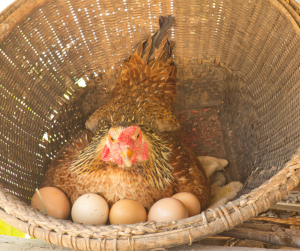At what age will my hens start and stop producing? Is there a breed that produces best? Is there a breed that produces best? How can I help my flock produce to the best of their ability? Do the seasons effect my hens? These are all such important questions to ask yourself as a flock owner. We all want our flocks to thrive and honestly, what is the point in a chicken (besides a pet) if they aren’t producing to the best of their ability? Though they seem like complicated questions, the answers are very black and white. Let’s dig in to the simplicity of maximum egg production!

At what age will my hens start and stop producing? – the anticipation is killing you; I know. Been there. Done that. Fortunately, because chickens grow so fast, you can expect your hens to start producing around the age of 16 – 24 weeks. Exciting right? Now on the other hand… Laying hens only average about 72 good weeks of laying. After this they slowly lay less and less until they eventually stop laying completely.
Is there a breed that produces best? – If eggs are your first priority when it comes to your flock, there are a few breeds that have really “pushed the envelope” when it comes to egg production. Breeds like ISA Brown, Rhode Island Reds, Leghorns, Sussex, and Australorps are all great choices when it comes to mass egg production. These breeds range from crossbreds to purebreds, so when it comes down to making your decision, I suggest doing some research!
How can I help my flock produce to the best of their ability? – The answers here are quite basic. Chickens are simple creatures, but there are a few key things that will help them thrive:
Good nutrition: Laying hens require a protein rich chicken feed that also includes an adequate amount of calcium. Your laying hens’ diet should consist of a protein level between 16% and 20%, as well as balanced level of vitamins, minerals, and calcium. Check the guaranteed analysis information listed on your current feed to ensure your hens are getting what they need. I personally feed NatureServe Layer Pellets, this feed has a 17% protein level and is jam packed with all kinds of goodies like probiotics, prebiotics, essential oils, and omega 3 fatty acids.
Let them be chickens: Chickens need time to be chickens. Time to scratch and roll around in the dirt, pick at some bugs, and blow off some steam. Without this time, they may become stressed and destructive to themselves or flock mates. Self-destructive behaviors like feather picking and bullying other members of the flock is not a good thing to have going on. Make sure you’ve got an adequate amount of space in your run to accommodate these things. Happy and healthy hens lead to a greater volume of eggs.
Do the seasons effect my hens? – Absolutely! Chickens pay attention to the seasons just like we do! They run off of something called “biorhythms”. Biorhythms are nature’s cues to chickens that tell them when start laying, mating or molting. Most people allow their hens to live out there day to day lives pretty naturally and freely. Owners that do not interfere with the biorhythms will naturally see a fluctuation in egg production across different seasons. Laying hens usually start laying in the spring and stop producing in autumn when their feathers start to molt. As we come into the fall season here in Indiana, I’m starting to see my hens slow down on production.
I hope you find this information as valuable as I did when I got my flock! Having a better understanding about things that help with egg production will surely help you ramp up production as you implement them into your personal flock care routine! I hope you all have a great week and happy laying!